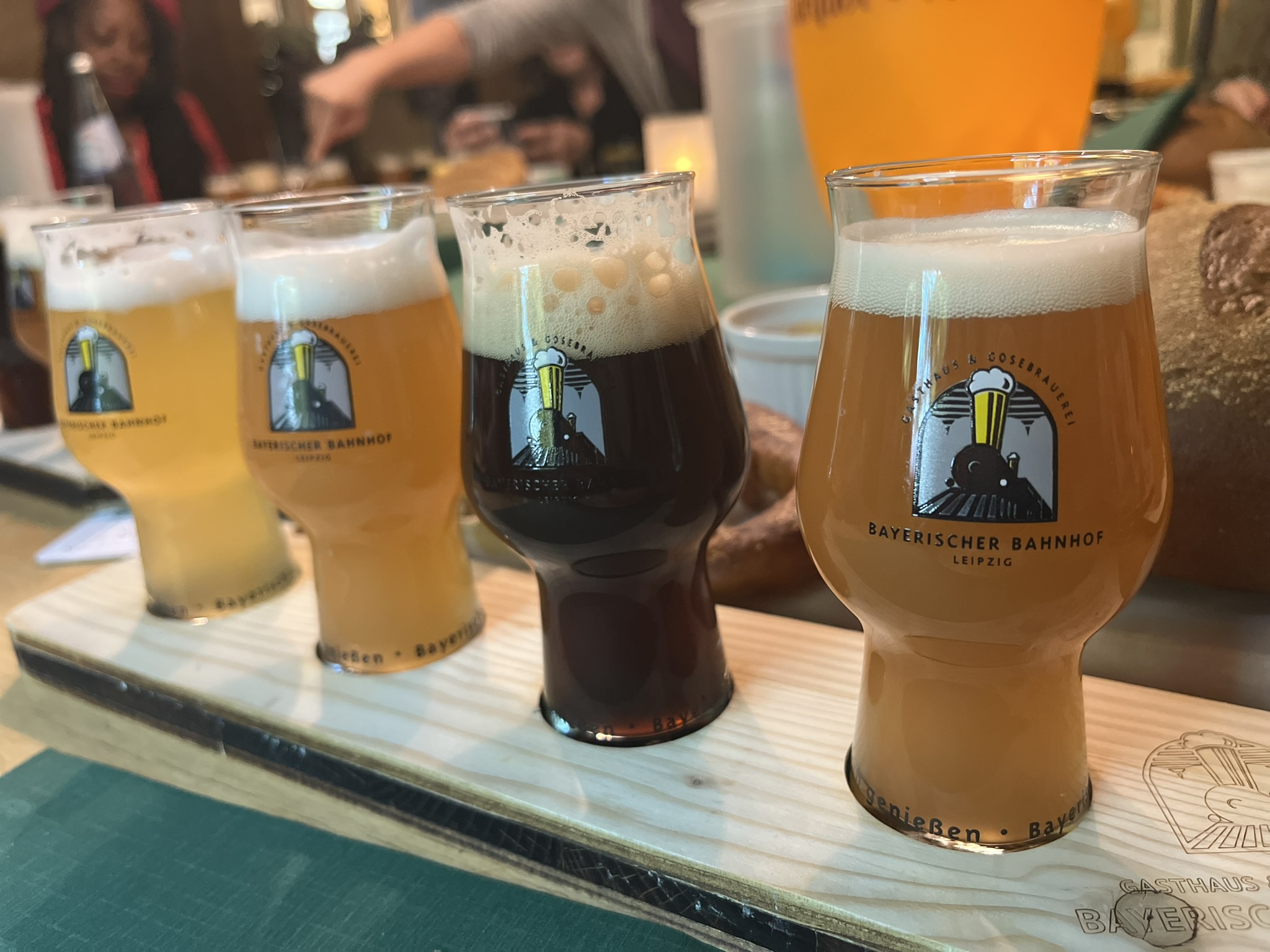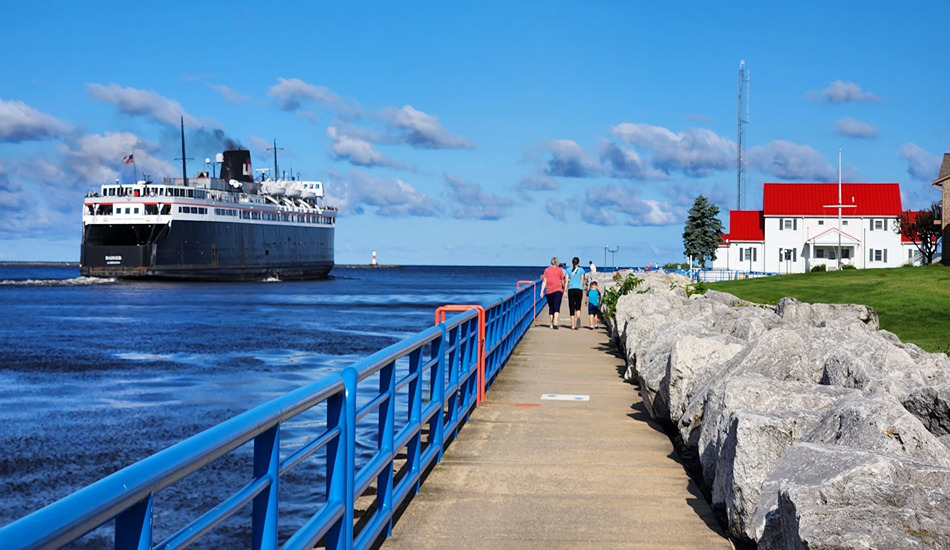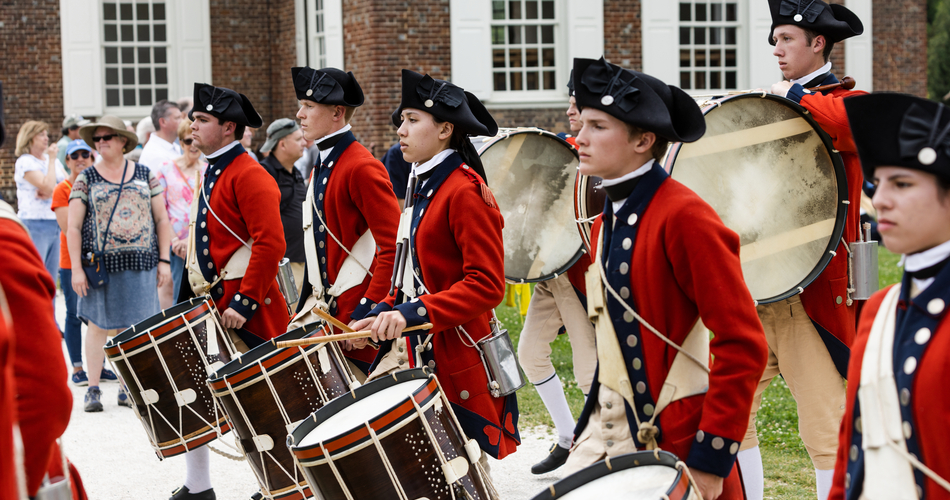Architectural treasures, an impressive art center, and food and drink specialties provide more than enough to captivate inquisitive travelers in Leipzig
Leipzig, Germany, is known as a city of world-class music and a place where important religious strides were made during the Protestant Reformation. It is rich with historic churches and organs, music festivals, opera and ballet.
The Gewandhaus Orchestra, Bach Museum, Mendelssohn House, Schumann House, St.Thomas Boys’ Choir, St. Nicholas Church and Leipzig Music Trail appeal to music- and church-centric tour groups. But Saxony’s largest city is more than just its musical and religious history.
Winding Waterways
You might be surprised to learn that Leipzig has about 500 bridges (more bridges than Venice) and contains more than 124 miles of flowing waterways. This allows for endless water recreation and opportunities to explore the beautiful city by boat. From Stadthafen Leipzig, the city harbor, you can rent kayaks or book tours on motorboats.
Cruising down the Karl Heine Canal with good-natured Captain Ingolf Neumann is an especially fun trip, as you can giggle at the wide-ranging experience levels of kayakers on the water. At one point passengers must duck down to waist-level to pass underneath a low-hanging stone bridge. During the ride, you glide alongside ducks through calm waters, listening to songbirds in the trees overhead and passing lovely villas on both sides. You might even get the chance to pass underneath harnessed tightrope artists as they practice their skills above the water.
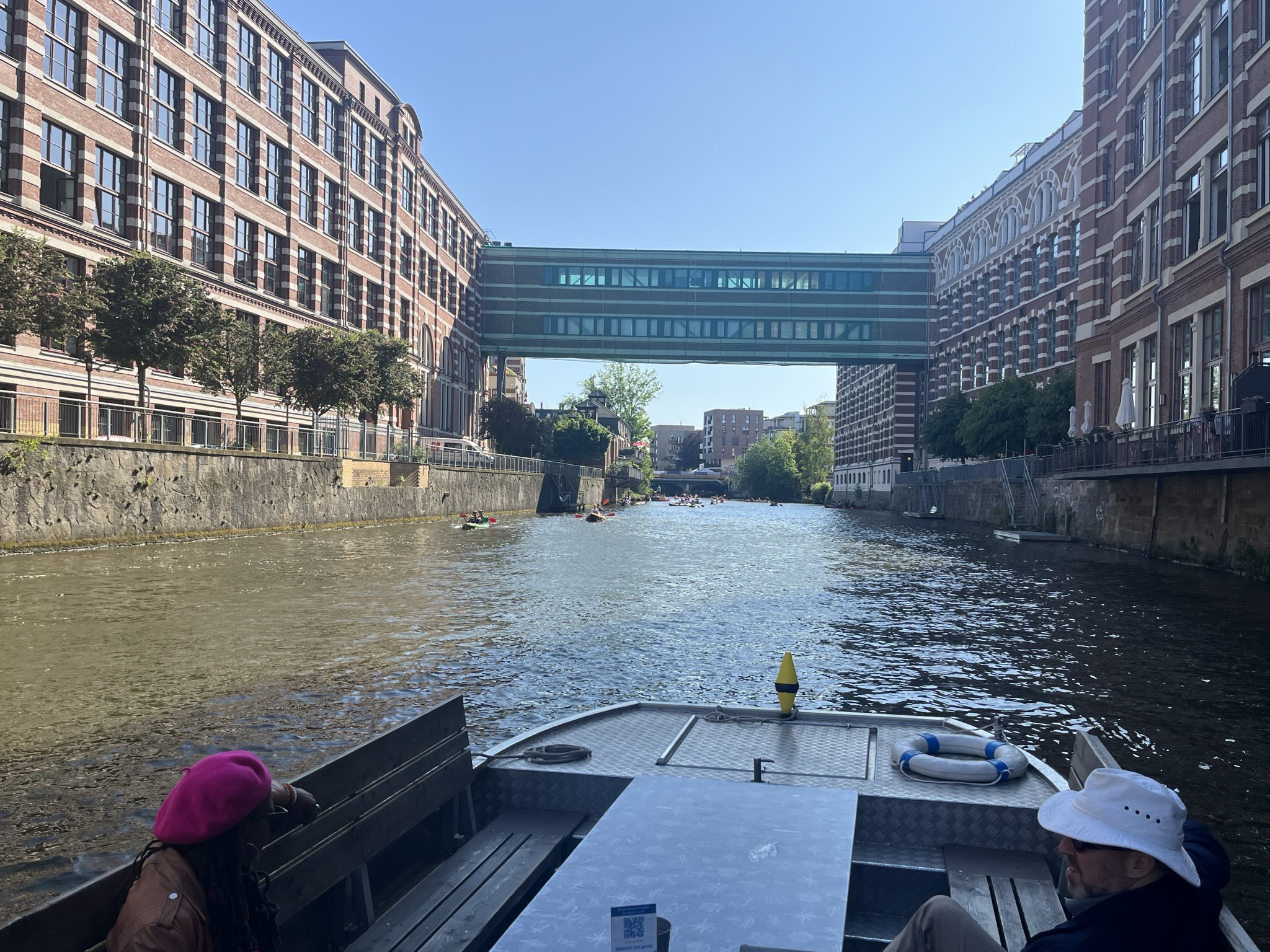
For a relaxing tour of Leipzig, take a boat ride down the Karl Heine Canal.
The boat ride launches at the small city beach, where you can grab a bite to eat and sip refreshing drinks with your toes tucked in the sand. In the summer months, shows and event-related entertainment take the beach stage.
Leipzig lies inside the crossing of three rivers—the White Elster, Pleiẞe, and Parthe. Fishing was once an important part of the city’s economy, which largely led to the famous regional dish, Leipziger Allerlei, a meal of mixed vegetables and seafood. Only available in several Leipzig restaurants, this combination of morels, peas, asparagus, carrots and crayfish can be served exclusively during May and June, the months outside of crayfish conservation season and within asparagus season.
City Sites
Leipzig’s Old Town Hall displays its Renaissance grandeur in the central market square. This has remained the town’s main market area since 1420, when it hosted trade fairs and publicly enforced Criminal Court judgments. On Katharinenstraẞe, the Fregehaus is an excellent example of an 18th century Baroque bourgeois home, complete with a box bay window and likely built around 1535 as a merchant’s residence. The building is now a boutique hotel and shop.
Kretschmanns Hof on the same street is a six-story former trading house built between 1910 and 1912 that serves as a passageway between two rows of buildings. A similar mercantile courtyard structure—the last remaining from the trade fair period—is Barthels Hof, built between 1747 and 1750. This building features a sandstone bay window dating back to 1523 that belonged to the previous building, called the Golden Snake House. Bay windows such as this one were a clear sign of owners’ wealth, and this particular bay window is thought to be Leipzig’s oldest preserved portion of a Renaissance facade.
The site of former department store Kaufhaus Ebert, a building constructed between 1902 and 1904, now houses a bank headquarters but retains the building’s original design of gorgeously gilded front features. Situated on a street corner and in full view from many angles, this unique facade glints beautifully on sunny days. Other buildings around town feature metal ornamentations of animal forms, as the city’s largest business was once the trade of pelts and furs.
In the Burgplatz is the New Town Hall, a huge 600-room structure from the early 1900s, built on the former grounds of 13th century Pleiẞenburg, the castle that housed the famous Leipzig Debate. The Leipzig Debate in June 1519 was a three-week disputation between Martin Luther, Andreas Karlstadt and Johannes Eck—one that had been brewing since spring 1518. Eck refuted Luther’s 95 Theses and Luther’s belief that papal power was not biblically sanctioned. Using the printing press to help distribute cartoons and other propaganda, the two sides exchanged views and conveyed aggression before they met to discuss the nature and authority of the papacy, the role of free will versus grace in saving one’s soul.
Don’t miss the opportunity to see pecks Hof, a former 1909 trading house destroyed in World War II and then restored and turned shopping arcade and exhibition hall. This mall passageway has magnificent glass ceilings and three atriums displaying artwork by Bruno Griesel, Moritz Götz and Johannes Grützke.
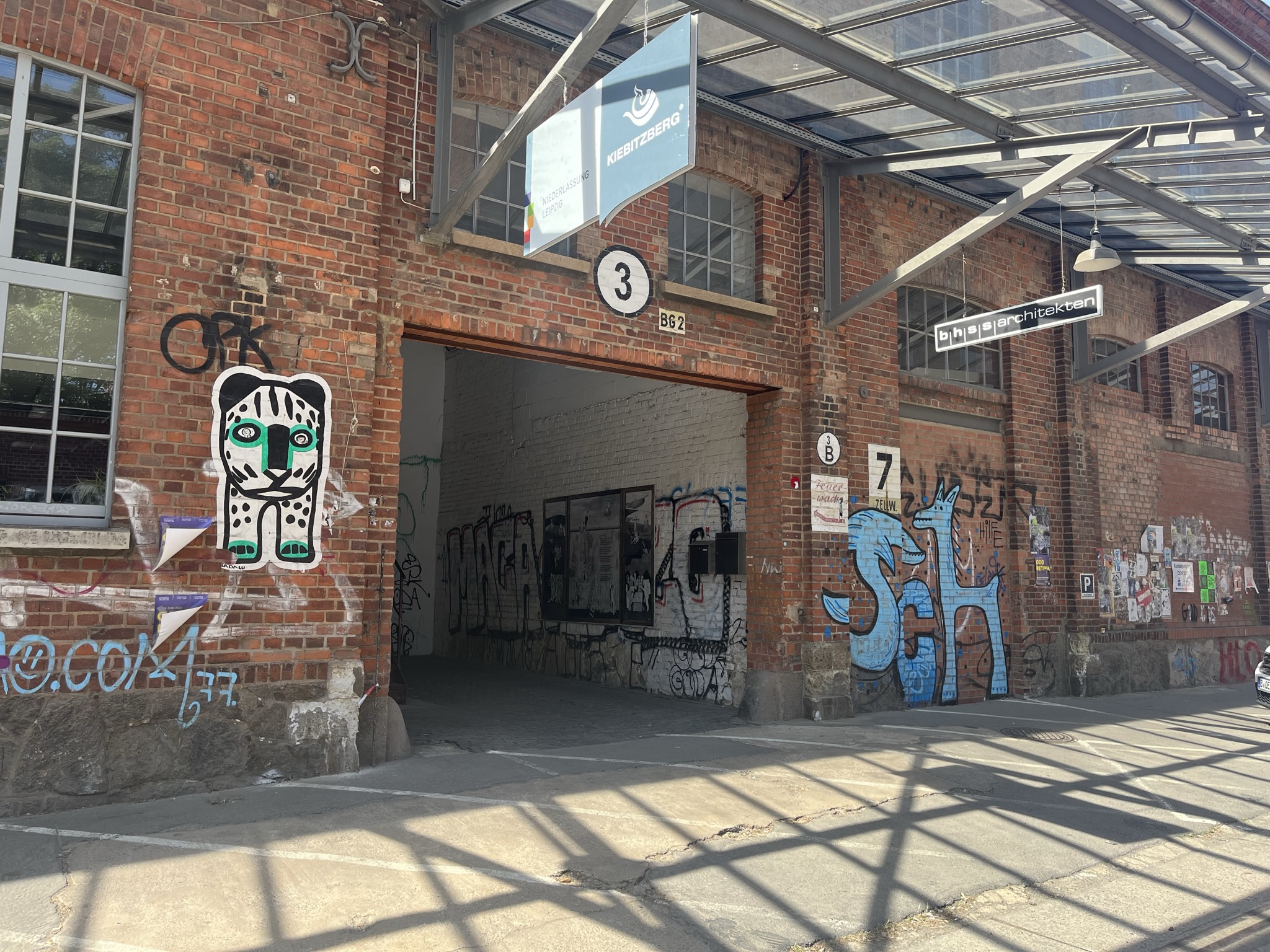
Spinning mill factory buildings and warehouses in the Spinnerei had an architecturally produced cooling system of thick walls that regulated the temperature to protect raw cotton and the final product—sewing thread—from damage and fires. Now, this temperature control system remains useful for the safety of supplies and artwork in the studio space.
Cotton Meets Culture
What was formerly the largest cotton spinning mill in 20th century continental Europe is now the epicenter of art in Leipzig. Housing 11 contemporary art galleries and exhibition spaces and more than 100 artists’ rental studios, the Spinnerei art center is a neighborhood in itself—a small factory town with its own art library, theater, cinema, cafe, printing house, wine shop and guesthouse, and the only professional art supply store in Leipzig.
A talented textile artist working in shared studio space at the Spinnerei is Andrea Garcia Vasquez, whose creative multi-material designs have been exhibited internationally. Another standout is painter Nicole Kegel, whose emotion-evoking oil on canvas collection was exhibited onsite in summer 2023.
Bahnhof Beer
Brewed in Leipzig in the Bayrischer Bahnhof (in the former buildings of a train station), Gose beer is a local specialty that contains salt and coriander, therefore not conforming to the German purity laws. The Reinheitsgebot purity law dictates that German beer can only contain water, barley, yeast and hops.
Unlike any other beer, with a taste that differs from the norm, Gose’s hazy golden-yellow unfiltered brew is slightly sour, somewhat dry and has an aroma of coriander. The beer is named after the Gose River in the town of Goslar, where it was originally brewed using the briny river waters. From 1738 onward, Gose was brewed in Leipzig and became the most popular beer in the city until the 19th century. Almost forgotten about after that point, the new home of a brewery within the old Bavarian train station building has brought back alive this beloved cultural staple.
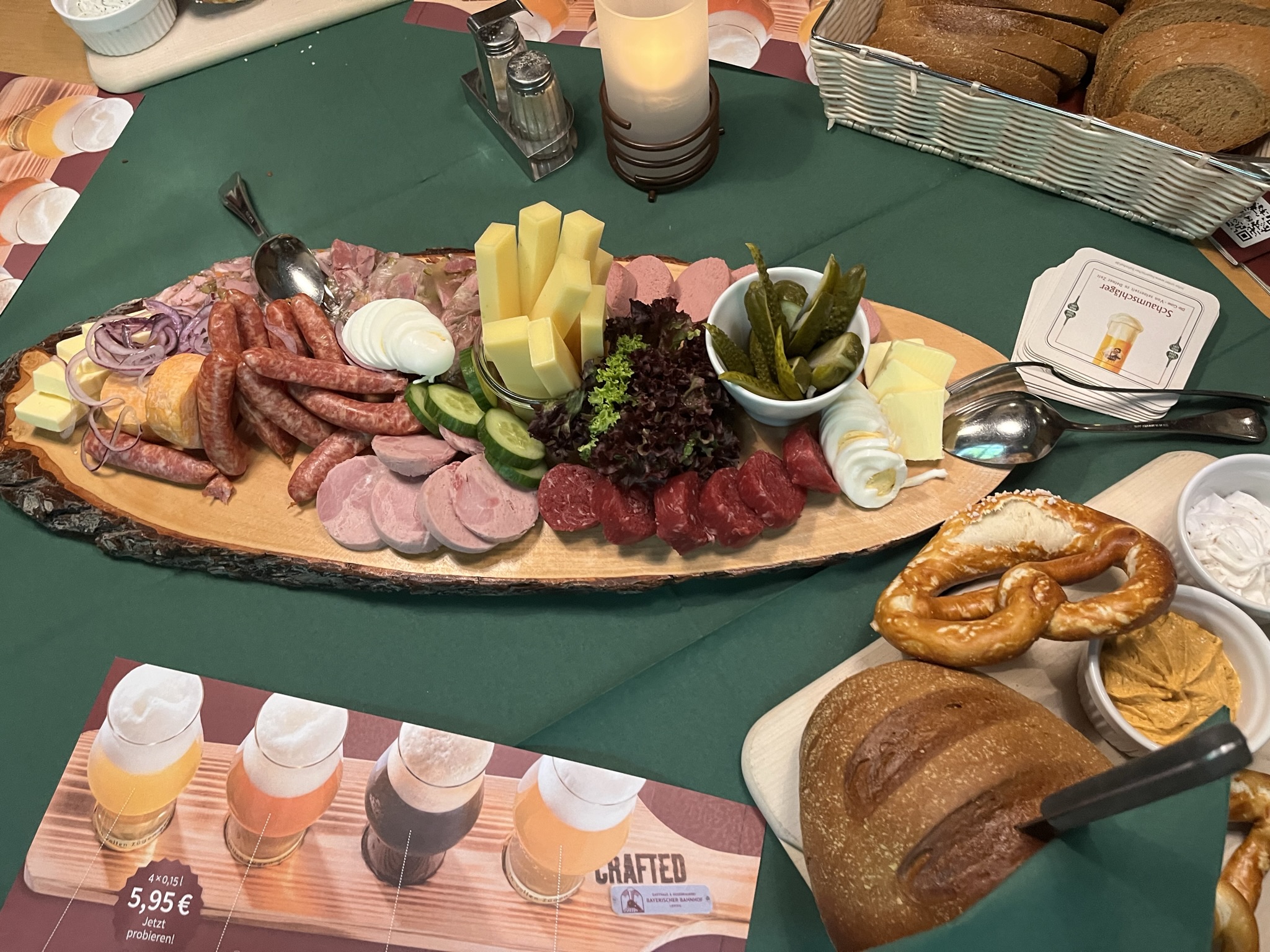
The menu at the Gose beer hall, housed in a former train station, offers the Fränkischer Brotzeittler, similar to a charcuterie board. The cheeses, meats, vegetables, breads and spread pair wonderfully with the beer.
Some people like to mix Gose beer with raspberry, cherry, or woodruff syrup, or caraway or cherry liqueur. The official toast for this Leipzig specialty is to raise your glass and shout, “Goseanna!”
Confections and Coffee
The Leipziger Lerche (Leipzig Lark) dessert was born as part of the animal protection movement in the 19th century. Songbird larks used to be hunted and baked with herbs and eggs into a pastry crust and then served as a hearty delicacy. This culinary luxury was enjoyed in Leipzig and beyond, and many bird carcasses were bound in twine and shipped from Saxony to various countries around the continent for others to cook. The bird-baking business boomed, and the bird population declined. In 1876, after overhunting and a severe storm had killed off many of these birds, King Albert of Saxony banned lark trapping.
To combat the suffering of this Leipzig business, some clever confectioneries in Leipzig then created a marzipan-stuffed shortcrust tart as a substitute for the traditional meat quiche. Now served in a small, fluted muffin cup, like a miniature pie, this baked good features two strips of dough crossed over the top to represent the trussing used to tie up stuffed larks. Beneath the ground almond and egg white mixture of the tartlet, there is often a cherry or dollop of jam to symbolize the heart of the lark. Kandler Konditorei in Leipzig is a popular source for Kandler Lark pastries of this style, baked fresh daily and as naturally and preservative-free as possible, with numerous packaged options sold for a sweet, Saxony-specific souvenir.
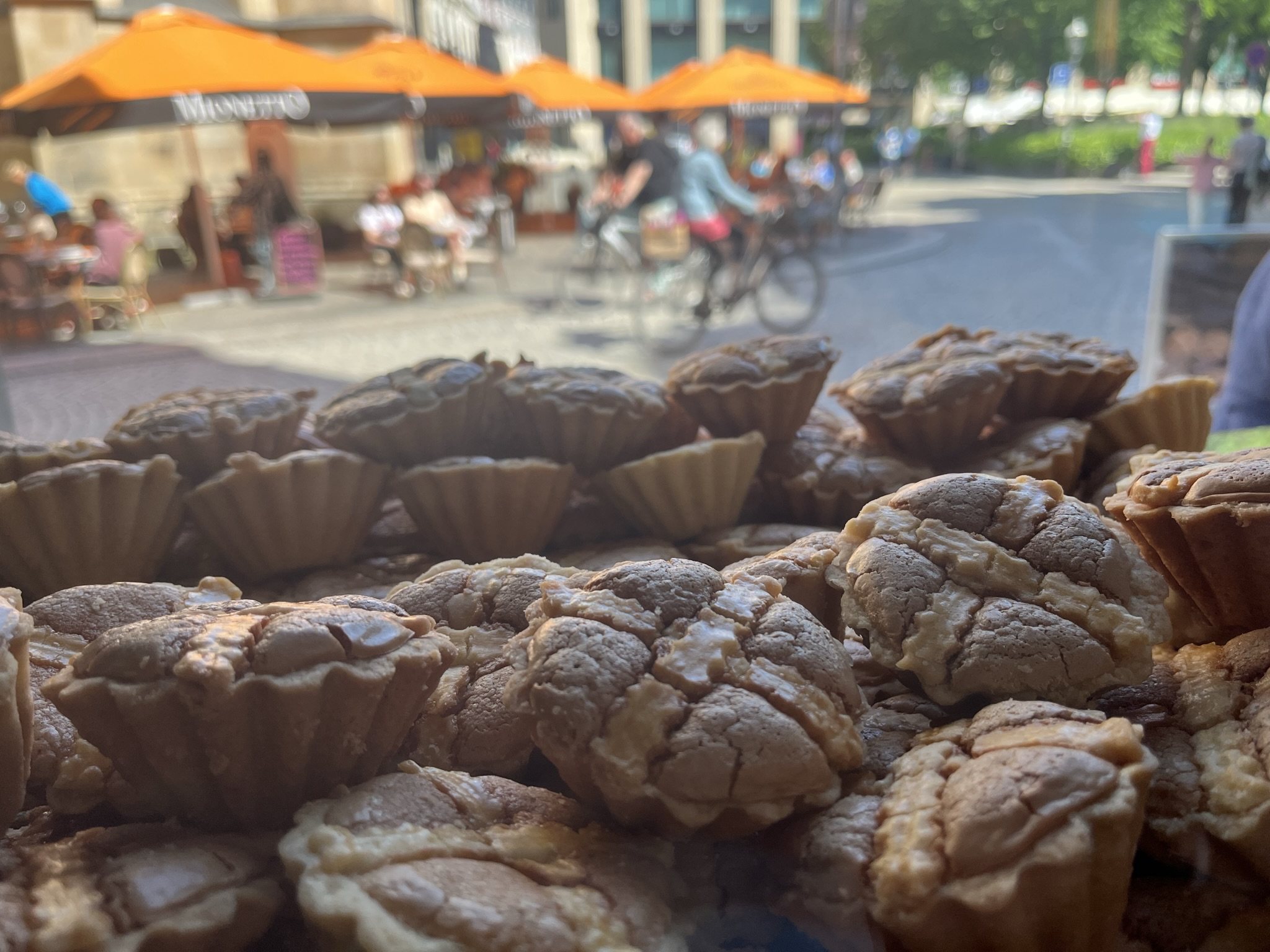
A marzipan-filled mini-pie, the Leipzig Lark pastry was invented in 1876 as part of an animal protection movement.
The Leipzig Lark treat is tasty alongside a steaming cup of coffee, and Europe’s oldest existing coffee shop is found in Leipzig. Zum Arabischen Coffe Baum (To the Arabian Coffee Tree) dates back to 1720 and contains a free museum showcasing artifacts from Saxony’s long-standing love of coffee. Although the cafe and museum are currently closed for renovations, a reopening is anticipated for summer 2024.
Wine and Witch’s Brew
Another important city stop is Auerbach’s Keller, a restaurant that will celebrate its 500th anniversary in 2025. Widely known as part of the setting for Johann Wolfgang von Goethe’s Faust, this famous wine bar and student hangout in the historic basement rooms beneath the Mädler Passage shopping arcade was a favorite locale for Martin Luther. He was a friend of the cellar’s founder, Heinrich Stromer von Auerbach.
As a controversial reformer, Luther had many enemies in Leipzig, so he would favor safe places where he knew he’d be protected—Auerbach’s Keller was one of those secure destinations. In the basement rooms, you can see murals and art pieces, including the 2012 painting by Volker Pohlenz portraying the secret December 3, 1521, meeting between Luther and von Auerbach, with whom excommunicated outlaw Luther sought refuge and stayed with safely overnight before resuming his travels to Wittenberg the next day.
Guests at Auerbach’s Keller can experience a 30-minute “In Luther’s Footsteps” tour to learn all about Martin Luther and his time in Leipzig and enjoy the four-course meal of the day in the cozy cross-vault-ceilinged Luthersaal (Luther room).
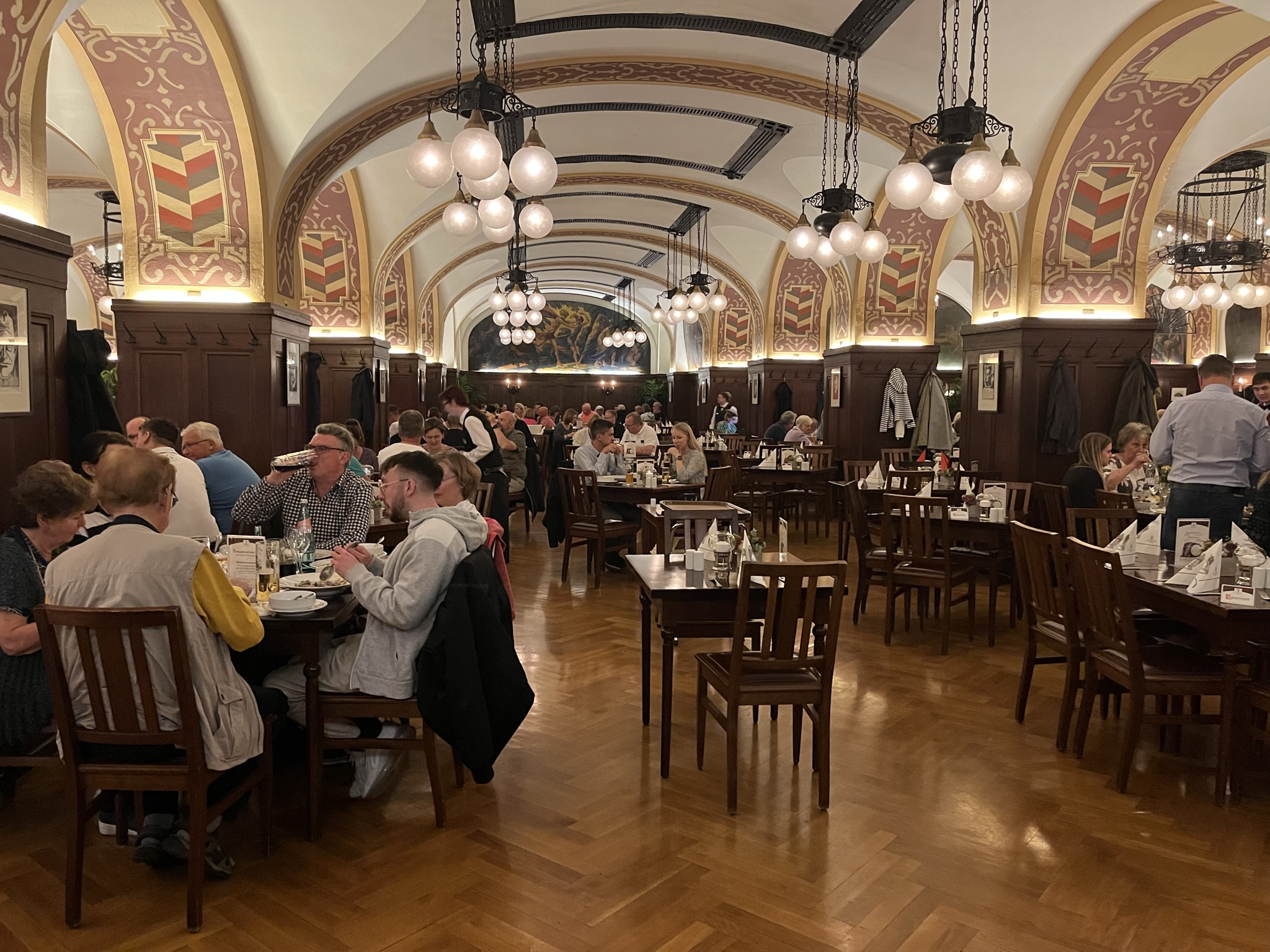
Goethe was a regular guest at Auerbach’s Keller while he studied law at the University of Leipzig. Themes from his Faust play are found throughout the restaurant.
Goethe’s fascination with this wine cellar began when he studied law in Leipzig from 1765 to 1768. His hours spent at Auerbach’s Keller inspired some of his literary themes. An art piece carved from a single tree trunk and hanging from a basement ceiling in the Goethe Room visually tells the story of the Walpurgis Night celebration, an annual gathering of witches described in Goethe’s Faust play. Early University of Leipzig students were restricted from going to the wine bar, and a solution to this rule was that a secret tunnel was built in the cellar, connecting the bar to the university campus.
In this bottommost room containing the secret passageway, guests can take part in the intriguing Faẞkeller Ceremony. After a special Mephisto’s Fire cocktail and a meal, participants of this tour are led down into the cellar’s dark Hexenküche (witches’ kitchen) for a ritual ceremony that involves sampling a rejuvenating “magic drink” like the fabled one shared by Faust and the Devil. On display outside the door to this room is a valuable historic wine barrel like the legendary vessel that magician Johann Faust was said to ride out of the cellar, and Faẞkeller Ceremony guests are welcome to pose on the barrel for photos.
Auerbach’s Keller serves a tasty ice cream variation of the regional Eierschecke 3-layer pastry, a treat only found in Saxony and neighboring areas. This bundt-cake-shaped mound of ice cream is seated on a petaled crust and topped with a dark chocolate medallion stamped with “Auerbach’s Keller Leipzig” and an image of Dr. Faust riding astride a wine barrel. Knowing Goethe and Luther were regular guests of Auerbach’s Keller, it’s a treat to dine in the historic basement rooms where they sat and eat traditional Saxonian cuisine, including this new take on a famous regional dessert.
In the Mädler Passage, marking the entrance to the restaurant, stand two bronze sculptures created by Mathieu Molitor—one statue of Mephistopheles and Faust faces the other—a grouping of students being bewitched by Mephisto. To this day, university students rub the foot of Dr. Faust for good luck before exams—evidenced by his foot’s golden color. The rest of the shopping passageway features many high-end leather goods stores.
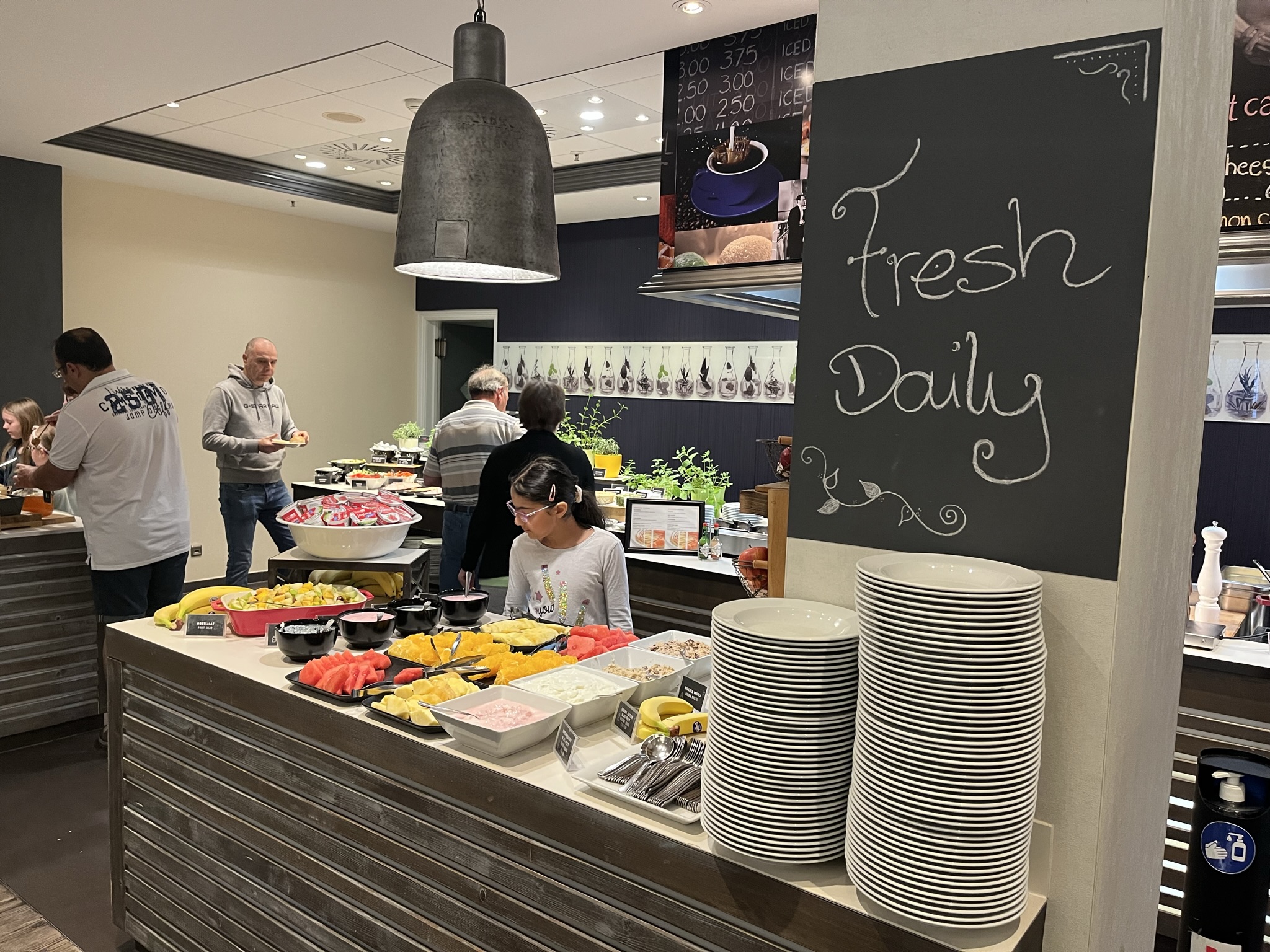
A posh city center hotel with a sumptuous breakfast spread and hip lobby bar, the Leipzig Marriott is a great place to start and end your day.
Homey Hospitality at the Leipzig Marriott
As a trade fair hub, Leipzig’s city center used to be reserved for tradesmen’s homes and their businesses, with guesthouses only situated around the city’s outer ring. Now, however, visitors can overnight in the city center at hotels like the Leipzig Marriott, where the fluffy white duvets and pillows make you feel like you’re sleeping in a cozy marshmallow. Showers stocked with full bottles of shampoo, conditioner and cleansing gel make showering extra-satisfying without having to rely on travel-sized containers. A swimming pool, hot tub, gym, lobby bar, and an absolutely fantastic breakfast buffet spread with fresh breads, jams, meats, fruits, hot dishes, and delicious made-to-order omelettes and lattes round out this hotel as a truly top-notch lodging choice.
These attractions, as well as the University of Leipzig, PPorsche Experience Center, the annual goth festival and six adventure worlds full of animals at the Leipzig Zoo are all awaiting your arrival. Gather your travel group, plan your trip to Saxony, and know that Leipzig has much to offer in addition to classical music and churches.
For more travel ideas on Europe, be sure to Subscribe to Leisure Group Travel magazine for FREE.
Story and photography by Alison Ramsey
Lead photo – At the Bayerischer Bahnhof, try the unique flavor of traditional Gose beer or order a flight to taste some variations.


